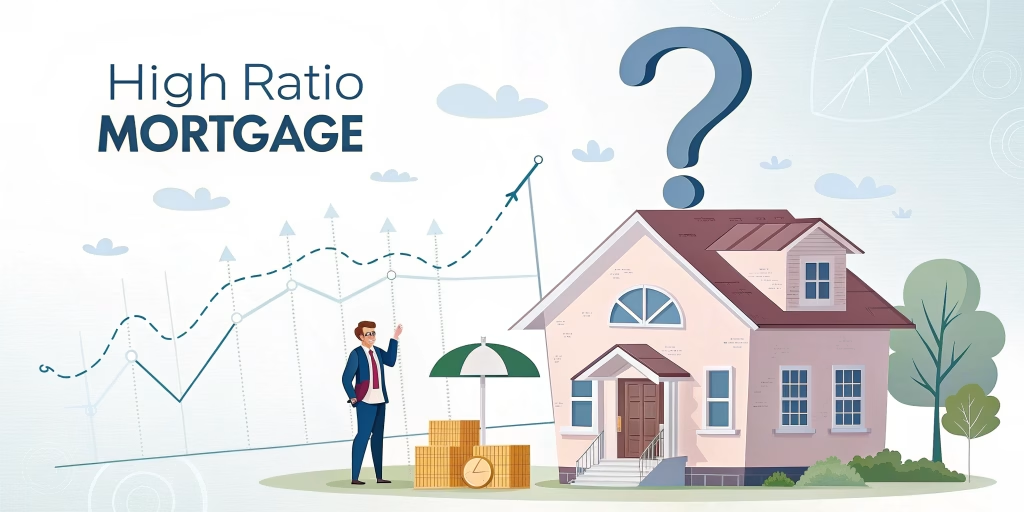Buying your first home can feel hard. There are many things to think about. Down payments. Interest rates. Monthly costs. You may hear the term “high-ratio mortgage.” If you don’t know what that means, don’t worry. I felt the same way when I bought my first home! But once I learned about it, I felt better. Today, I’ll explain it step by step. You’ll feel more sure about this big choice.
What Are High-Ratio Mortgages?
A high-ratio mortgage is a home loan. The buyer puts down less money up front. This is usually less than 20% of the home’s price. That’s the “high ratio” part. It means the loan amount compared to the home’s value. The less you pay up front, the higher your ratio. This means you borrow more of the home’s value.
Think of it this way. Your dream house costs $400,000. You saved $20,000 for a down payment. That’s only 5% of the total cost. You didn’t reach the 20% mark. That would be $80,000 in this case. So your loan is a high-ratio mortgage. Your ratio would be 95%. This means you’re borrowing 95% of the home’s value. Simple, right?
But there’s a catch. High-ratio mortgages often need something called “mortgage default insurance.” We’ll talk about this later.
How Do High-Ratio Mortgages Work?
When I first found out about high-ratio mortgages, I felt excited and nervous. Here’s how they work:
Step 1: Apply for the loan You gather your money details. Lenders check your credit score. They check your income. They check how much you can pay up front. Knowing this helps you feel in control of buying your home.
Step 2: Get approved You put down less money. So lenders usually make you buy mortgage default insurance. This extra step protects them if you miss payments.
Step 3: Get your rates and terms You may see that interest rates for high-ratio mortgages are a bit higher. This helps the lender deal with extra risk.
Step 4: Close the deal You provide your down payment. You pay for insurance. You close the deal on your mortgage.
When you understand how high-ratio mortgages work, you’re better ready to buy your home.
Down Payment Needs and Effects
One big question in my journey was about down payment needs. This is key when you want to know what a high-ratio mortgage is.
Minimum Down Payment Needs:
- With a high-ratio mortgage, you pay less than 20% of the home’s price up front
- In some cases, lenders let you pay as little as 5% up front
Understanding Down Payments:
- A smaller payment up front means a bigger mortgage balance
- This affects your monthly payments
- It also means you pay more interest over time
How Down Payment Size Affects Mortgages:
- A lower payment up front can lead to higher monthly costs
- This is because you borrow more money
- The extra fees and costs also include mortgage default insurance
A study by Ratehub.ca found something important. Buyers with low down payments pay up to 3% more in total fees. This happens over the life of their mortgage. By watching minimum down payment needs, you can better figure out your total home buying costs.
Mortgage Default Insurance Explained
One hard part for many buyers is learning about mortgage default insurance. I felt overwhelmed when I first heard about it. But it’s not as bad once you break it down.
What It Is:
- This insurance protects the lender if you can’t make payments
- It’s required when your down payment is below 20%
How It’s Figured Out:
- The cost is often a percent of the mortgage amount
- It’s based on your down payment
- For many borrowers, this adds extra cost
Benefits:
- It lets you buy a home with less savings
- The insurance protects both you and the lender
Stats and Views: Data from Investopedia shows something important. Mortgage default insurance makes up a big part of the total cost in high-ratio mortgages. But many buyers see it as a needed expense in a tough market.
When you learn about mortgage default insurance, you understand something key. While this insurance raises your costs, it also opens the door to owning a home sooner.
Interest Rates and Payment Time
After looking at numbers and reading my options, I saw how important interest rates and payment time are. Both play key roles in your monthly payments and total cost.
Interest Rate Trends:
- High-ratio mortgages sometimes have slightly higher interest rates
- This is because there’s more risk to the lender
Payment Period Insights:
- A longer payment period means lower monthly payments
- But it also means more total interest
- Many high-ratio mortgage holders choose a 25- or 30-year term
Real-Life View: I compared rates on several sites like Bankrate. I found that a small difference in rates can add up over time.
Key Things to Consider:
- Look at your plans. Will you move in a few years or stay long-term?
- Think about how much interest builds up over a long time
When you ask what a high-ratio mortgage is in terms of interest and payment length, think of it as a balance. You manage lower costs now versus paying more interest later.
Good and Bad Points of High-Ratio Mortgages
No money tool is perfect. Looking at the good and bad points of high-ratio mortgages is key. Here’s an honest look based on personal experience and expert reviews:
Good Points:
- Lower Starting Cost: You can buy a home with less money saved
- Quick Market Entry: Great for first-time buyers who haven’t saved much
- Flexibility: Some buyers prefer saving their money for other needs at first
Bad Points:
- Higher Costs Over Time: You pay more in insurance and interest
- Risk of Debt: The higher loan balance might be hard in the long run
- Extra Fees: There are added charges that add up
Balanced View: It’s key to think about the good and bad points carefully. A trusted friend once told me, “Make sure you see both sides before making that big step.”
Understanding the good and bad points can help you decide if your money situation is right for this option.
High-Ratio vs Regular Mortgages
If you’re still wondering what a high-ratio mortgage is and how it compares to other types, let’s look at the differences.
Key Differences:
- Down Payment Size: Regular mortgages usually need 20% down
- Insurance Needs: High-ratio mortgages need mortgage default insurance. Regular mortgages do not.
Who They Work For:
- High-Ratio Mortgages are better for buyers with limited savings
- Regular Mortgages might work for buyers who saved enough for a bigger down payment
Other Differences:
- The total cost over time can be lower with regular mortgages
- This is because there are no extra insurance fees
- High-ratio borrowers might pay higher interest rates
Personal Note: I looked at both options closely. For many, the choice comes down to current savings and comfort with extra fees.
This comparison clearly shows the key differences. It shows that every buyer’s needs are unique.
Other Options Besides High-Ratio Mortgages
After thinking about what a high-ratio mortgage is, it’s normal to wonder about other paths. There are several other options if you’re not ready for that extra insurance and higher interest rates.
Regular Mortgages:
- Need a down payment of 20% or more
- Usually offer lower total costs
Government Help Programs:
- Many programs help first-time buyers
- They may offer rewards or lower fees
- This makes home buying easier
Other Money Options:
- This includes shared equity mortgages
- Loans from private lenders
- Some options might offer more flexible terms
By looking at other options, you can see if a regular mortgage or government help program might better meet your needs. It’s all about finding the option that fits your situation best.
Figuring Out and Planning Mortgage Costs
Once you know what a high-ratio mortgage is, the next step is planning your budget wisely. Knowing how to figure out costs and plan for extra expenses can keep you on track.
How to Figure Out High-Ratio Mortgage Costs:
- Start with the purchase price
- Subtract your down payment to get the mortgage amount
- Add mortgage default insurance costs and any extra fees
- Use online calculators for quick estimates
Planning for Extra Expenses:
- Besides the monthly mortgage payment, plan for property taxes
- Plan for utilities and maintenance
- Plan for closing costs and other fees
- Create a simple budget using a spreadsheet or budgeting app
Step-by-Step Budget Tips:
- List every expected expense
- Set aside savings for unexpected costs
- Check your budget regularly to make sure you stay on track
Understanding how to figure out costs and plan for extra expenses is key to avoiding money surprises later.
Making Smart Mortgage Choices
At the heart of my home-buying experience was the need to make careful choices. Now, whenever I hear the question “what is a high-ratio mortgage,” I remember that it’s a smart but sometimes costly entry into real estate.
Key Choice Factors:
- Down Payment: Review minimum down payment needs and think about how much you can save
- Costs: Understand the money effects of high-ratio fees and costs, such as mortgage default insurance
- Long-Term Plans: Think about how long you plan to live in your home
Personal Guidance: When I was deciding on my mortgage, I compared notes with experts on sites like Investopedia and Bankrate. I also talked with friends who had experience with high-ratio mortgages. Their advice helped me see both the benefits and risks.
Action Steps:
- Do your research
- Use multiple online tools to figure out costs
- Talk with a trusted mortgage advisor to clear up doubts
Final Thoughts on Making Choices: Reading reviews and making comparisons between high-ratio mortgages and other options gave me clarity on my choice. Don’t rush. Take your time to understand every term and cost.
Through careful research and honest thinking, you can confidently figure out what a high-ratio mortgage is and how it might fit into your life. This journey is about making smart choices and planning for a stable future.
Making Smart Mortgage Choices
High-ratio mortgages are like a two-sided sword. They can help you get into the housing market sooner. But they come with higher costs and duties. The key is to fully understand the trade-offs. Figure out what works for your situation.
If you’re still unsure, talk to a mortgage broker or money advisor. They can guide you through your unique situation. Owning a home might seem hard. But with the right knowledge, you’re one step closer to reaching your dream.





